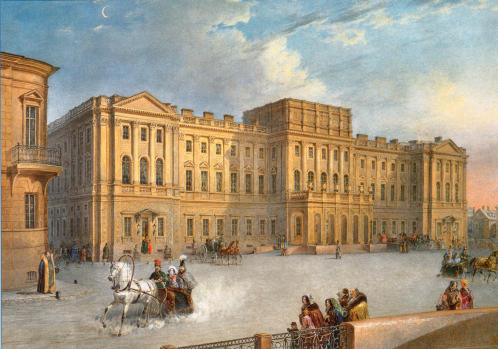|
Paul Von Lilienfeld
Paul Frommhold Ignatius von Lilienfeld-Toal (russian: Павел Фёдорович Лилиенфельд-Тоаль, translit=Pavel Fëdorovič Lilienfel'd-Toal'; french: Paul de Lilienfeld; 1829–1903) was a Baltic German statesman and social scientist of imperial Russia. He was governor of the Courland Governorate from 1868 till 1885. During that time, he developed his ''Thoughts on the Social Science of the Future'', first in Russian as ''Мысли о социальной науке будущего'' (Mysli o sotsial'noi naukie budushchego; 1872), and then in German as ''Gedanken über die Socialwissenschaft der Zukunft'' (1873–1881). Lilienfeld's thoughts, which he later articulated in compressed form in both French and Italian, laid out his organic theory of societies, also known as the social organism theory, organicist sociology, or simply organicism. He later became a senator in the Russian parliament, as well as vice-president (1896), then president (1897), of ... [...More Info...] [...Related Items...] OR: [Wikipedia] [Google] [Baidu] |
State Council Of Imperial Russia
The State Council ( rus, Госуда́рственный сове́т, p=ɡəsʊˈdarstvʲɪn(ː)ɨj sɐˈvʲet) was the supreme state advisory body to the Tsar in Imperial Russia. From 1906, it was the upper house of the parliament under the Russian Constitution of 1906. 18th century Early Tsars' Councils were small and dealt primarily with external politics. Peter I of Russia introduced the Secret Council. Catherine I of Russia introduced the Supreme Secret Council. Its role varied during different reigns. Peter III of Russia created the Imperial Council on 20 May 1762 ("Императорский Совет"), or, formally "The Council at the Highest Court" ("Совет при высочайшем дворе"). It was dismissed shortly after the succession of Catherine II of Russia. 1810–1906 The State Council was established by Alexander I of Russia in 1810 as part of Speransky's reforms. Although envisaged by Speransky as the upper chamber of the Russian parliament, ... [...More Info...] [...Related Items...] OR: [Wikipedia] [Google] [Baidu] |
Russian Serfdom
The term ''serf'', in the sense of an unfree peasant of tsarist Russia, is the usual English-language translation of () which meant an unfree person who, unlike a slave, historically could be sold only with the land to which they were "attached". Peter I ended slavery in Russia in 1723. Contemporary legal documents, such as ''Russkaya Pravda'' (12th century onwards), distinguished several degrees of feudal dependency of peasants. Serfdom became the dominant form of relation between Russian peasants and nobility in the 17th century. Serfdom most commonly existed in the central and southern areas of the Tsardom of Russia and, from 1721, of the subsequent Russian Empire. Serfdom in Little Russia (parts of today central Ukraine), and other Cossack lands, in the Urals and in Siberia generally occurred rarely until, during the reign of Catherine the Great (r. 1762–1796), it spread to Ukraine; noblemen began to send their serfs into Cossack lands in an attempt to harvest their ext ... [...More Info...] [...Related Items...] OR: [Wikipedia] [Google] [Baidu] |
Saint Petersburg
Saint Petersburg ( rus, links=no, Санкт-Петербург, a=Ru-Sankt Peterburg Leningrad Petrograd Piter.ogg, r=Sankt-Peterburg, p=ˈsankt pʲɪtʲɪrˈburk), formerly known as Petrograd (1914–1924) and later Leningrad (1924–1991), is the second-largest city in Russia. It is situated on the Neva River, at the head of the Gulf of Finland on the Baltic Sea, with a population of roughly 5.4 million residents. Saint Petersburg is the fourth-most populous city in Europe after Istanbul, Moscow and London, the most populous city on the Baltic Sea, and the world's northernmost city of more than 1 million residents. As Russia's Imperial capital, and a historically strategic port, it is governed as a federal city. The city was founded by Tsar Peter the Great on 27 May 1703 on the site of a captured Swedish fortress, and was named after apostle Saint Peter. In Russia, Saint Petersburg is historically and culturally associated with t ... [...More Info...] [...Related Items...] OR: [Wikipedia] [Google] [Baidu] |
Pāvilosta
Pāvilosta (; german: Paulshafen) is a small port town in South Kurzeme Municipality in the Courland region of Latvia. It is located at the mouth of Saka river. The population in 2020 was 881. History The territory of modern Pāvilosta has been inhabited since the Stone Age. During the late Iron Age and the Livonian crusade the territory was inhabited by Curonians and was part of the Piemare land. In 1253 in an agreement between Bishop of Courland and Livonian Order port at the mouth of Saka river is mentioned for the first time. In the later years small port named Sackenhausen was part of the Bishopric of Courland, Duchy of Courland and Semigallia and since 1795 Russian Empire. In 1879 local landlord from nearby Upesmuiža manor Otto Friedrich von Lilienfeld started extensive reconstruction works of the small port. The new port town was named Paulshafen, after baron's brother General governor of the Courland Governorate Paul von Lilienfeld. However, development of the t ... [...More Info...] [...Related Items...] OR: [Wikipedia] [Google] [Baidu] |
Courland
Courland (; lv, Kurzeme; liv, Kurāmō; German and Scandinavian languages: ''Kurland''; la, Curonia/; russian: Курляндия; Estonian: ''Kuramaa''; lt, Kuršas; pl, Kurlandia) is one of the Historical Latvian Lands in western Latvia. The largest city is Liepāja, the third largest city in Latvia. The regions of Semigallia and Selonia are sometimes considered as part of Courland as they were formerly held by the same duke. Geography and climate Situated in western Latvia, Courland roughly corresponds to the former Latvian districts of Kuldīga, Liepāja, Saldus, Talsi, Tukums and Ventspils. When combined with Semigallia and Selonia, Courland's northeastern boundary is the Daugava, which separates it from the regions of Latgale and Vidzeme. To the north, Courland's coast lies along the Gulf of Riga. On the west it is bordered by the Baltic Sea, and on the south by Lithuania. It lies between 55° 45′ and 57° 45′ North and 21° and 27° East. The name is also ... [...More Info...] [...Related Items...] OR: [Wikipedia] [Google] [Baidu] |



